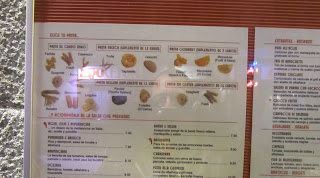I’m not sure why Seville is the more famous city in Andalucía, because Córdoba has it beat hands-down. Its history is every bit as illustrious as its larger competitor, but it’s clean and smaller, so it has a quaintness about it that eludes Seville. Pre-urban settlement existed there in the 8th century B.C., then the Romans conquered it in 206 B.C. and made it the Roman capital of the Iberian peninsula. After the fall of the Roman Empire, it became a Christian city, and in 711 A.D. it was conquered by the Moors who made it their provincial capital city. It is estimated that in the 10th century and beginning of the 11th century, Córdoba was the most populous city in the world and during these centuries became the intellectual center of Europe. Córdoba had 3,000 mosques and received what was then the largest library in the world, housing from 400,000 to 1,000,000 volumes. Who knew??
 |
| Cathedral Tower |
| Bishop's crest mounted over Arabic |
During the renaissance Córdoba lost its population and by the early twentieth century only had about 20,000 inhabitants, but it has since grown to about 330,000 people. Being the smaller city in the shadow of Seville, it has managed to keep its charm. The narrow, winding streets with potted plants create the photo-image that most people have of the Andalusian region. And like Seville, it has some of its original medieval city walls and gates.
But the thing for which Córdoba is most famous, and what I was completely in awe over, is the mosque. Its interior striped arches are possibly the most recognizable image of Spain and for good reason. They are completely mesmerizing. During the height of the Moorish rule, the mosque was built on top of the foundations of an earlier Christian church, and over the centuries was added onto to become the enormous mosque complex that it is today.
 |
| Flemish style vaulted ceiling atop Arabic arches |
But when the Christian Iberians retook the city, they converted the mosque into a cathedral. They removed the center of the mosque and put in a taller, soaring section that projects past the roof of the old mosque with clerestory windows all around. But the mosque, being as enormous as it was, still wraps completely around the Christian section of the building with 856 columns, so the floor plan flows easily between church and mosque. What remains is a fascinating collision of Arabic and European styles, like I’ve never seen before. The cathedral in Seville was a similar conversion, but the contrast of styles is not nearly as stark, because the cathedral there is predominantly Gothic. I was enthralled by the Mezquita-Catedral of Córdoba.
 |
| Chris - Christian ceiling & Arabic walls |
 Outside the Mezquita-Catedral, I took a photo of Chris standing next to one of the weather-worn gothic foundations across the street. Then we had lunch on a sidewalk cafe and enjoyed the beautiful weather.
Outside the Mezquita-Catedral, I took a photo of Chris standing next to one of the weather-worn gothic foundations across the street. Then we had lunch on a sidewalk cafe and enjoyed the beautiful weather. 
 |
| Inner courtyard (I can't figure out how to rotate this picture!) |













































